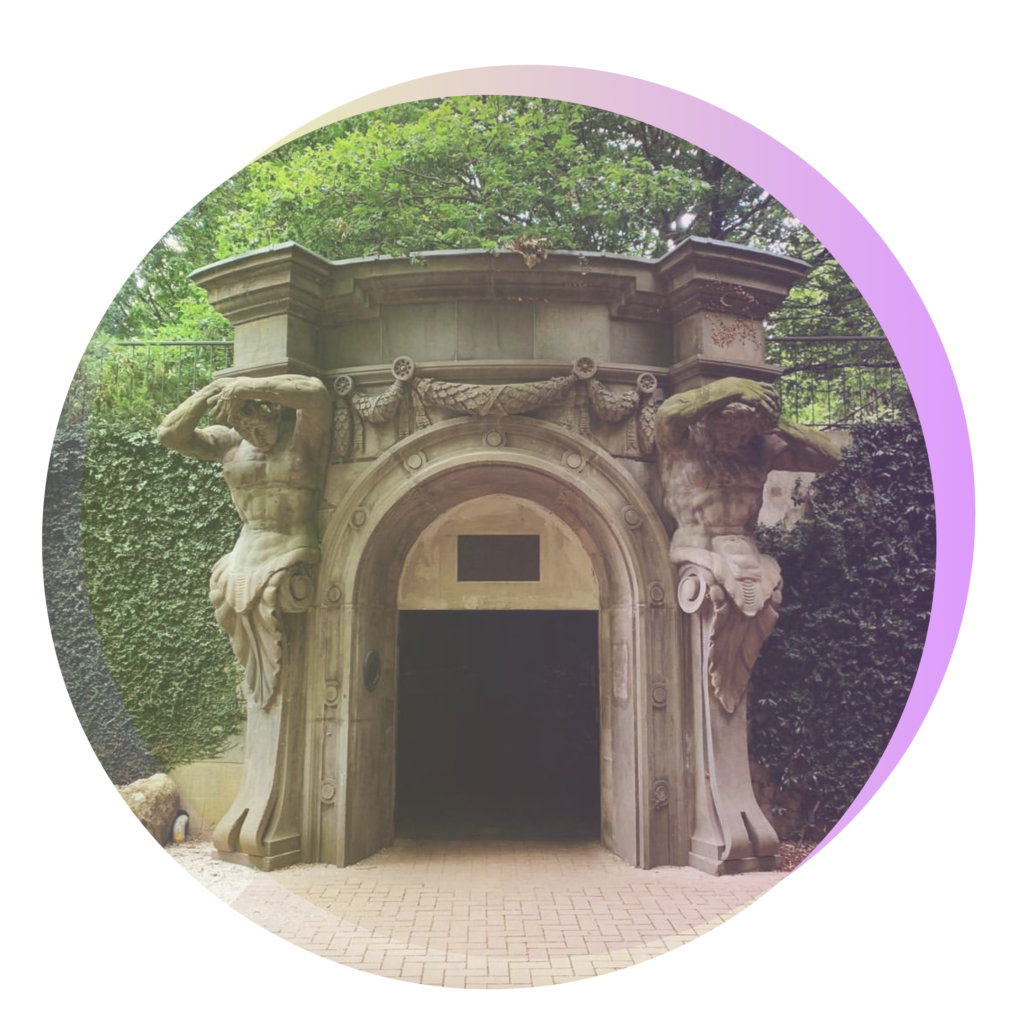THE SKY WE CARRIED

by Dr Rachel Hennessy
Perspective: Atlantes statues at the entrance of the South Lawn Carpark (c1880)
Get directions: 37°47’55.6″S 144°57’35.5″E
It is heavy, carrying this weight, my arms continually raised, my head always lowered.
You know I know I don’t really feel, that my stone has no pulse, no thought, no pain. I am an ornament on this portico, with limited functionality, though it is the ornamental that has saved me.
This is my third site/sight. Once I was in the throbbing heart of the city, part of the banking sector. I welcomed the loan manager and the applicant, watching them enter my space, one straight-backed and cocky, the other sweaty. My half-body made them stop sometimes, compare their own torsos, the fragility of their flesh.
But they knocked down that building, and my brothers and sisters – slabs of concrete not turned into anything as splendid as I – were returned to the clay from whence they came.
I arrived at this place of learning, me and my designated brother – he’s there to the left of me looking even more strained, as if his eyes might pop out of his head – and we were erected where the physiology students could admire us. A suitable gracing of an entrance, a building for those completely concerned with the workings of the human body. We watched them come and go, Professors and students, straight-backed and cocky, sweaty and nervous. They stopped too, aware of our origins as the god, Atlas, supporter of the sky, held by a belief in their own immortality.
But they knocked down that building as well – my lesser concrete siblings once again slaughtered – and put us on this entrance to a … carpark. It feels somewhat less important, less grandiose, for a couple of gods, to hover at the entrance to a dark and gloomy space reserved for machines, although they do say it was used in a movie about life after the end of the world.
We are passed by now, an occasional glance, a smirk from the first years, a wondering as to our purpose, a loss of any reverence for what we once held up (the sky, do you understand, the sky!)
Across from us, there is another demolition occurring. Slabs of concrete lain out, one on top of another, steel spikes sticking out like ribs, the rods that once held them together exposed and laid bare. We witness their return to sand again and wonder what our fate will be.
Don’t we, brother?
He does not reply. He has remained stubbornly quiet these one hundred and forty-five years.
I have heard them speak of our protection under the National Trust. They talk about this idea, trust, as if we are immune to the possibility of destruction. I have spoken to the archway, and I am not so sure. There are plans, they say, there are always plans to knock down, to start again, to arrive at a clean slate, as if we are nothing but an impediment.
The dust rises from over the way, the jackhammers beat into the skin of my family, and I know trust can be broken, our bodies ripped open easily, our solidity turned into the pieces that are not worth keeping.
Fancy responding to the Statue?
ABOUT THE AUTHOR
Dr Rachel Hennessy is the award-winning author of five novels: The Quakers (2008), The Heaven I Swallowed (2013), River Stone (2019), Mountain Arrow (2020) and City Knife (2023). She is a Lecturer in Creative Writing at the University of Melbourne.
Words from Rachel
I walk past these statues most days, noticing the moss growing on their arms. Upon returning to campus this year I saw the building opposite them was being demolished and I thought about how we value certain stone – that which is shaped into something artistic or ornamental – whilst being unconcerned with smashing apart other forms. These created objects give us pleasure maybe because they are shaped into something familiar whilst a wall is only utilitarian. I considered how the word “trust” implies stability and whether a statue that has been moved numerous times might not be able to maintain trust that things would not change for them, that they too might be returned to rubble. The fact that I needed to use an object that was in the form of a human being perhaps speaks to my innate anthropocentrism, but we all have to start somewhere…
FIND OUT MORE
Discover some of the South Lawn Carpark’s lore on Wikipedia.

Your comment will be reviewed before it will be posted here. Our team of editors will also curate a selection of responses for publication in our anthology.